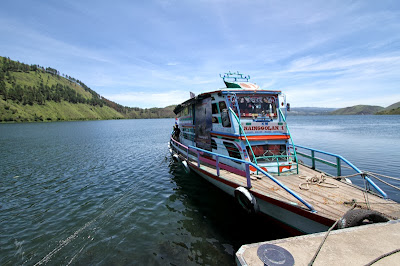Today Ojak Silaban posted pictures of Sihol and her children
on Facebook. I look at the beautiful children. Sihol’s grandmother would have
been proud of them. I remember weaving with her one afternoon when the sound of
church bells came wafting over the rice field. Ompu ni Sihol sat up and took
notice. Someone had died. It was a child. We walked over and visited the
mourners and I saw the deep sadness in Ompu ni Sihol’s face. I do not know how
many of her own children she had buried, but only one son had survived. How
thrilled she would have been to have had these healthy, smart, great
grandchildren!
The ‘Back to the Villages’ expedition with Rangsa ni Tonun
had to include Ompu ni Sihol’s village in Harian Boho to pay homage to the
woman who had provided ‘The Weaving Song, the theme song of the film. I had taped
her in 1980 while she sang and reeled yarn to demonstrate the use of the
iraniran, or Batak reel. Thirty years later, Suarasama made a musical arrangement for it and performed it for our film.
On 16 September, 2013, our boat sailed toward Harian Boho and we docked at the empty marketplace.
It wasn’t market day and the
morning market was over, too. The last time Nashir and I had been there was
2010. We knew our way to the coffee-tent, but it was a very hot day and there
was almost nobody there. That had been one venue that we had considered for
showing the film. There was no need to say anything to each other. We knew it
wouldn’t work.
 |
| See how barren the hills have become. They used to be covered in forest growth. |
Se
 |
| MJA Nashir took these beautiful photographs of our approach to Harian Boho and our boat at the dock. |
We started to climb the path to Ompu ni Sihol’s village. It
was a path that I used to love to walk in the cool, verdant forest. It took me through
rice fields first and then along a stream. I had had to wind my way around
megaliths and huge tree roots. How I wish I could have given my team that
experience, but the modern path is flat and paved and straight. And so hot
under the tropical sun! So many of the Batak villages have used heavy equipment
to shift the rocks and have poured concrete mortar between them to make
flattened stretches that are easily negotiated on foot and by motor vehicle.
Modern, maybe, but no longer delicious.
We finally found Ompu ni Sihol’s village, deserted and
empty. Her son’s house is still standing and he was there with his very young
granddaughter.
| Ompu ni Sihol's son's house. It was once a traditional Batak house but had been cut down to make a modern bungalow. |
| Ompu ni Sihol blind son was there with his granddaughter. |
He was blind. This wasn’t a good place to show the film, either.
I was suffering from the flu and I wasn't much use because I could only think of lying down. We sat together on the
front veranda of the house and Nashir saved the day.
He began to play the soundtrack of Rangsa ni Tonun that starts out with Ompu ni Sihol’s quavering old voice. Her son recognized it immediately, noticeably. We all watched his face. Then Nashir found his digital copy of my tape recording of her from 1980 in his computer and he played it for the old man.
The blind man sat back with a smile. He remembered his mother and the day. He enjoyed it. Playing that soundtrack was the best way to present Rangsa ni Tonun in Ompu ni Sihol’s village.
| MJA Nashir evaluates the situation. |
He began to play the soundtrack of Rangsa ni Tonun that starts out with Ompu ni Sihol’s quavering old voice. Her son recognized it immediately, noticeably. We all watched his face. Then Nashir found his digital copy of my tape recording of her from 1980 in his computer and he played it for the old man.
 |
| Ompu ni Sihol's son enjoyed listening to his mother's voice. (Photograph by Febrina Pakpahan) |
The blind man sat back with a smile. He remembered his mother and the day. He enjoyed it. Playing that soundtrack was the best way to present Rangsa ni Tonun in Ompu ni Sihol’s village.
And then we took our leave. I made sure that I snapped
photographs of her house this time.
| Ompu ni Sihol's house in 2013. |
Who would believe me that she had lived in
such a little, impoverished hut? The lean-to beside her hut is no longer there,
but the stones on which she balanced her earthenware pots and dyed her yarn are.
I tried to picture the village as it had once been. I found it hard to do.
 |
| Ompu ni Sihol's house in 1980. |
Bits
and pieces of memory came back. We wandered over to her grave. I remembered the
rice fields with the church on the other side. I had forgotten how lush the
trees beside the village were.
I rejoiced in being able to catch a glimpse of
how the Batak villages in Harian Boho must once have been. I could see that now
although I cannot remember having seen that thirty years ago. There was still bamboo growing
atop the rocks surrounding the village. The stages of decay have been slow and
have left traces.
Then we left the desolate village and made our way back under
the merciless tropical sun to the boat.

No comments:
Post a Comment